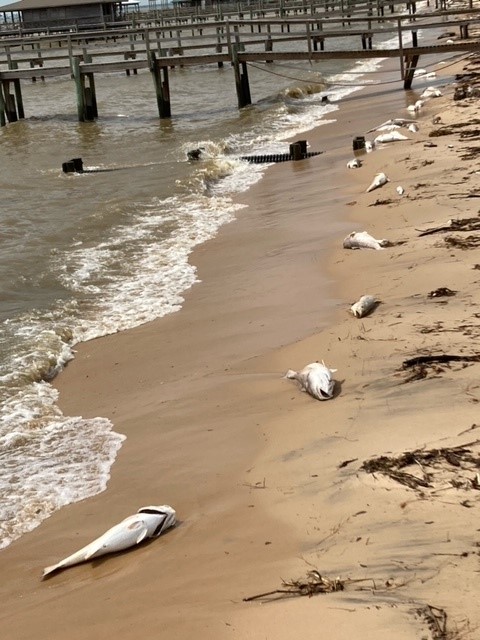
by Rick O'Connor | Apr 21, 2022
This began with a call from one of my volunteers who was checking salinity at Shoreline Park. She reported the salinity, but also reported to smell of dead fish – though she could not see them. I visited Shoreline Park the following day on another project and could smell it as well. There was a large amount of dead seagrass washed ashore from a recent storm and I thought this may be the cause of the smell because I did not see the dead fish either.
When I got home, I checked the FWC fish kill database. It reported a redfish kill in Pensacola Bay. It is unusual to see a kill of only one species. Many times, these are releases from fishing activity, particularly bait, and thought this must be the case – FWC did not mention the cause. I let the volunteer know and asked to keep an eye out.
I reported this to the Escambia County Division of Marine Resources to (a) let them know, and (b) to find out if they had any idea of cause. They replied that the location was incorrect. The kill was actually near Galvez Landing on Innerarity Point. He (Robert Turpin) had visited the site and did find any dead fish. I have a lot of volunteers over that way so asked each to take a look. They did not see any dead fish. I asked them to keep an eye out and collect a dead fish if they saw one for testing. Often when a large fish kill occurs, and it is only one species, the suspect cause is disease. Tissue samples could confirm this.
And then came another call.
This time it was from one of our Master Naturalist who lives on the eastern shore of Mobile Bay. He wanted to know what was up with all of the dead redfish along the shore of the bay. He sent photos and his beach was littered with them. I reached out to Mississippi/Alabama Sea Grant to see if they knew what was going on. They had heard about the situation and knew the Alabama Department of Natural Resources was collecting samples. The Gulf Islands National Seashore then reported large numbers of dead redfish along the National Shores property in Mississippi, something was up.

Dead redfish on the eastern shore of Mobile Bay.
Photo: Jimbo Meador
I eventually got word from Dr. Marcus Drymon at the Dauphin Island Sea Lab. They had a team working on this. Their team reported that stratification of the Gulf had created a hypoxic (low dissolved oxygen) layer on the bottom and the male “bull redfish” had gathered for breeding and died.
So, we are back to our title – what is stratification and how did this cause the fish kill?
Stratification is the layering of the water. Less dense water will sit atop the more dense. Water temperature or salinity can cause this density difference and layering. Colder and/or saltier water is denser and will form the bottom layer. If you have high winds, it will mix the water and the stratification disappears. Tides and currents can affect this as well.
What they believe happened recently was excessive amounts of rainfall created a large layer of freshwater to move from Mobile Bay into the open Gulf. The combination of tides and wind allowed a stratified layer to form. The oxygen that marine life uses is dissolved into the water at the surface and referred to as dissolved oxygen (DO). If the system is stratified, then the oxygen dissolved at the surface will not reach the bottom and hypoxia (low DO) can happen. They this is what happen. It just so happens that the large male redfish (bull reds) had congregated just offshore for breeding. They are more sensitive to low DO than the smaller females and any juveniles. So, the males died. To answer the question as to why other fish did not die (what you typically see in a DO related fish kill) – the numbers were not mentioned by there was one reference to 4.0 ppm. This is the high threshold of hypoxia. Many fish can tolerate at this concentration, but the male redfish could not.
So, that is what we think happened. The perfect storm of the demise of a group of male redfish just off of Mobile, and the carcasses drifted to other locations.
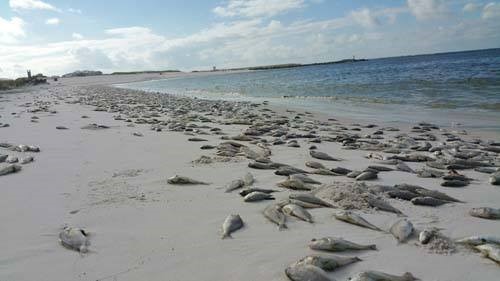
by Rick O'Connor | Oct 31, 2015
Many coastal Panhandlers woke up this week to the sight and smell of dead fish. Thousands of them washed ashore from Panama City to Pensacola. This mass die off included a variety of species including whiting, sheepshead, hake, cusk eels, and even lionfish; there were also reports of dead bass from the Dune Lakes in Walton and Okaloosa counties. What caused this mass die off of fish?
The suspect is red tide…
Most of us along the panhandle have heard of red tide but we may not know what it is or what causes it. Many attribute the red tide events to human impacts, stormwater runoff etc., but in fact they have been around for centuries. There are records suggesting that the European colonials experienced them and I have read one account that the Red Sea got its name from the frequency of these events there. So what is this “red tide” and what causes it?
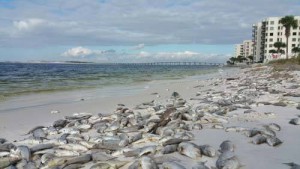
Dead fish line the beaches of Panama City.
Photo: Randy Robinson
It is actually a bloom of small single celled plants called dinoflagellates. There are thousands of species of dinoflagellates in the world’s oceans and not all cause red tide, but there are several species that do. These small microscopic plants drift near the surface of the ocean acquiring sunlight to photosynthesize. They possess two small “hairs” called flagella (hence the name “dinoflagellate”) to help orient themselves in the water column. Most have a shell covering their body called a theca and some shells have small spines to increase their surface area to resist sinking. One method of defense found in some dinoflagellates is the production of light – bioluminescence. This light is produced by a chemical reaction triggered by the creature as a flash of blue – many locals refer to it as “phosphorus”. Other dinoflagellates instead will release a toxin… some of these are ones we call “red tide”.
Red tide organisms are always in the water column of marine environments but are usually in low concentrations, maybe 300-500 cells per milliliter of water. But under favorable conditions, warm water with nutrients, they multiple… sometimes in great numbers, such as 3000-5000 cells/ml, and we have a “bloom”. The number of cells within these blooms can be high enough that we can actually see the water change color… hence “red tide”.
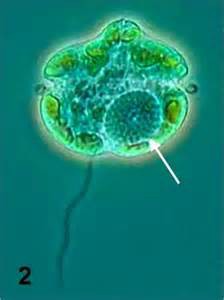
The dinoflagellate Karenia brevis.
Photo: Smithsonian Marine Station-Ft. Pierce FL
The most common red tide dinoflagellate associated with the Gulf of Mexico is Karenia brevis. Karenia blooms typically form offshore and are of little impact to the coastal communities. However when the wind and tides are right these blooms will drift towards shore. When they do fish kills occur and humans have eye and throat irritations. Marine mammals in particular struggle with red tide. As the bloom comes near shore it reaches the bottom of the water column and many of the bottom dwelling fish suffer. Most of the photos of fish I saw in the October 2015 fish kill were bottom dwellers, including many invasive lionfish.
Is there anything we can do to prevent red tides?
Not really… Again, they are naturally occurring event. We may increase the frequency of the events by discharging excessive nutrients into the water from our run-off but they would probably occur anyway. Red tide events are not as common in the panhandle as they are in southwest Florida. The Gulf waters near Charlotte Harbor are shallow, warm, and near the many manicured lawns, gold courses, and the discharge of much of the agriculture in the state. Occasionally blooms formed in that part of the state drift north but this year a bloom formed off of Bay and Gulf counties in early October. The recent storm that passed through probably pushed the bloom inland and to the west. The biggest hazard of humans is eye, throat, and skin irritation. It is quite uncomfortable to be around these blooms. In 1996 a local bloom was concentrated enough that the campground at Ft. Pickens had to be closed. I was in Galveston Texas when I heard about the red tide occurring in the Florida panhandle. As I was leaving Galveston the newspaper reported the closer of all oyster harvesting in Texas due to a red tide generated in the Padre Island area and was moving north. Seems that red tide is covering a large portion of the Gulf coast the last week of October. That said… anything communities can do to reduce nutrient runoff will certain decrease the frequency of red tides.
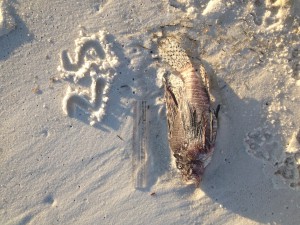
The carcass of the invasive lionfish was part of the October red tide kill.
Photo: Shelly Marshall
The Florida Fish and Wildlife Conservation Commission post red tide updates from around the state on their website and the Escambia County Extension Office post a local water quality update each Friday that has red tide information as well.
FWC
http://myfwc.com/research/redtide/
Escambia County Extension
http://escambia.ifas.ufl.edu

by Rick O'Connor | Jun 20, 2015
This past week hundreds of dead fish washed ashore between Escambia and Okaloosa counties. Most were of one species but there were others who died and it appeared they had been in the water for quite a while. Determining the cause of fish kill can be tricky. You can observe how many different species were involved, and how many of each species. You can also review changes in the biological and chemical environment of the water system impacted. Fish kills occur for a variety of reasons but many are connected to either a decline in dissolved oxygen, the presence of red tide, or some pathogen that may be affecting the fish.
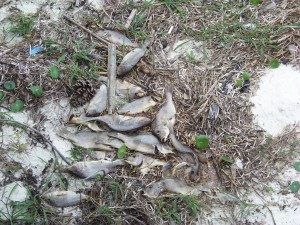
Dead fish near Ft. Pickens in Pensacola. Photo: Rick O’Connor
Excessive nutrients, many times associated with heavy rain, can trigger algal blooms that can eventually lower the concentration of dissolved oxygen; however high water temperatures can do the same. When dissolved oxygen levels drop below 4.0 mg/L most fish are stressed, and most fish leave. Some fish however are very sensitive to these changes and die, menhaden are one of them. The Florida Fish and Wildlife Conservation Commission listed menhaden as one of the species found on the beach but there were others as well, actually the majority were scaled sardines. The Florida Department of Environmental Protection monitors dissolved oxygen at the beach each week and their data indicated no problems prior to the kill. The Escambia County Division of Marine Resources measured the dissolved oxygen after the kill and found levels to be normal. Some would point to the abundant amount of green algae, “June grass”, as a sign of an algal bloom but mass amounts of June grass appear each summer and fish kills typically do not follow them.
Red tides are blooms of a particular microscopic single celled creature called Karenia brevis. When these photosynthetic protist are disturbed they can release a toxin which dissipates through the water and can become part of the aersols produced by waves. Many species of fish and marine mammals struggle with red tides and mortality due these outbreaks are common. Records of red tide blooms go back as far as the early colonial period and have been part of Florida for centuries. They typically form offshore and move inland with the wind and currents. Once they reach shallow waters human released nutrients can increase populations of K. brevis and enhance the problems they cause. They are more common in southwest Florida but do occur in the panhandle. Agencies along the Gulf coast monitor for red tide outbreaks each week. The Escambia County Division of Marine Resources does so here and found no traces of K. brevis before or after the kill.
As far as pathogens, or another possible cause, we are not sure. The Florida Fish and Wildlife Conservation Commission has officially listed the cause as “unknown”. Fish kill data in Escambia County shows changes over the years. In the 1970’s there were a fewer fish kills reported each year but each kill involved hundreds of thousands of fish, many times menhaden. Today there are more fish kills reported but many of these reports are a single fish or fewer than 10. This is the first large number kill we have had in a while. Escambia County Sea Grant reports water quality information, including fish kills and red tides, for the Pensacola Bay area each week on their website (http://escambia.ifas.ufl.edu). Fish kill information for the state of Florida can be found at http://myfwc.com/research/saltwater/health/fish-kills-hotline/. If you have any questions about local fish kills contact Sea Grant at your local county extension office.
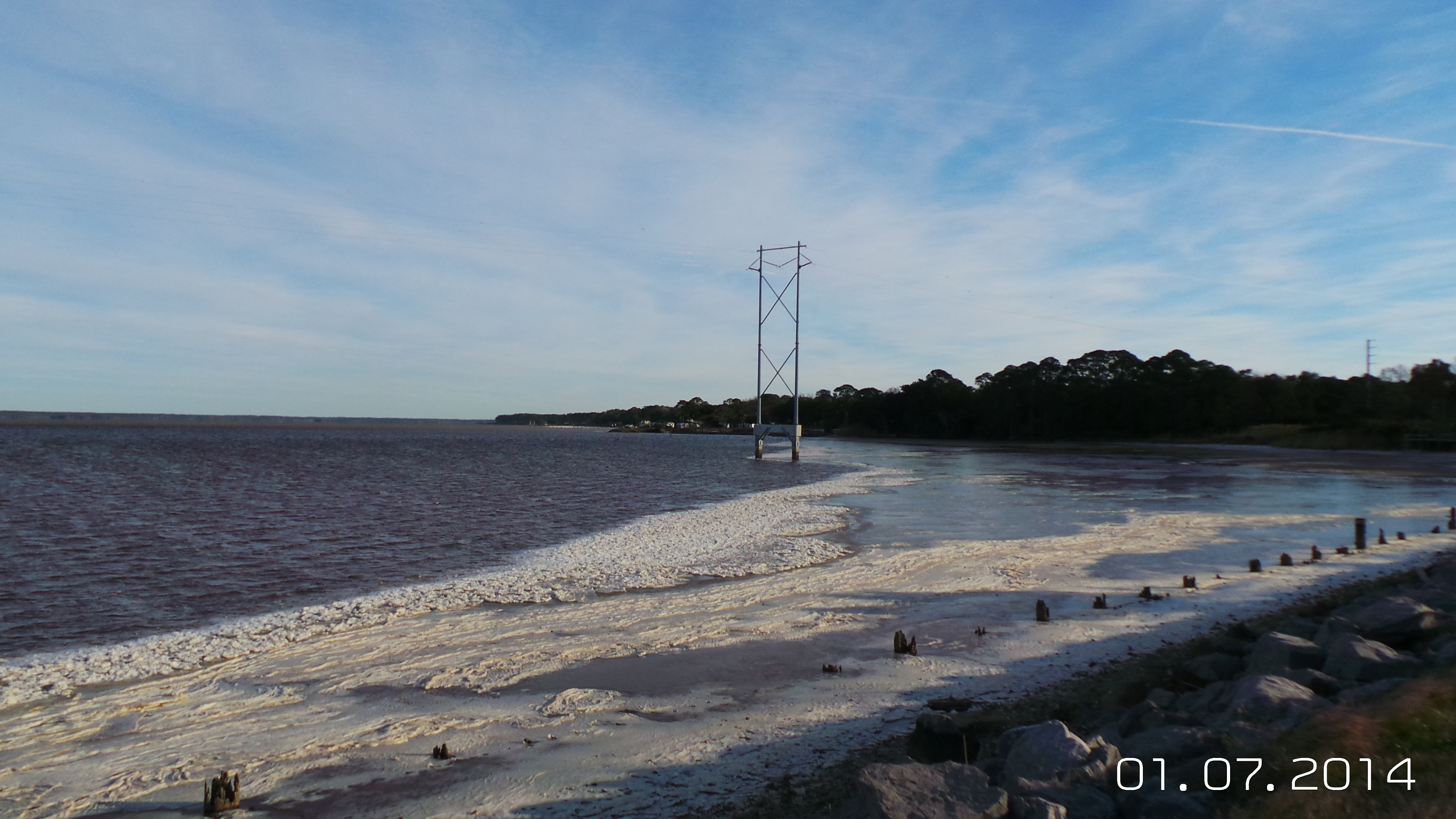
by Chris Verlinde | Jan 25, 2014
With the ongoing cold weather across the Panhandle, fish kills are being reported in many areas.
In the Panhandle, average water temperatures have dropped down to the 50s (degrees Fahrenheit) in many waterbodies. This is about ten degrees cooler than in normal years. Fish have a tolerance to temperature but when air and water temperatures decrease rapidly, fish kills may occur.
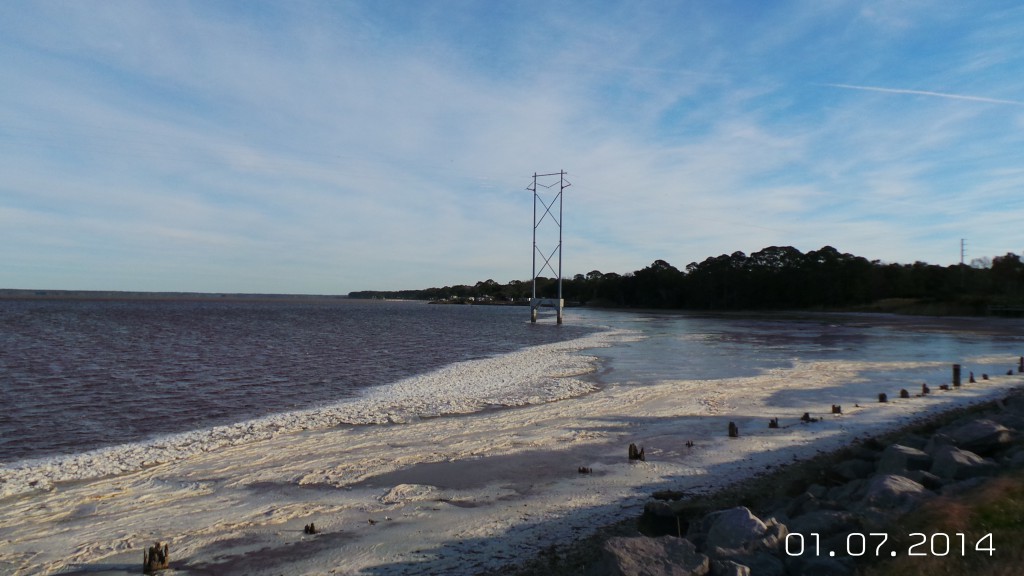
Recent ice coverage in Apalachicola Bay is visible example of the harsh environmental conditions that have led to reported fish kills throughout Florida, including the Panhandle. Photo by L. Scott Jackson
Fish kills due to cold weather are naturally occurring phenomena. In some cases there may be an ecological benefit. Exotic fish species that have adapted to Florida’s subtropical climate may not be able to withstand these colder temperatures and large numbers of the populations may be eliminated. The decrease in the population of exotic species may allow for an increase in native populations.
The Florida Fish and Wildlife Conservation Commission’s (FWC) Fish Kill Hotline provides maps of fish kills throughout the state on a monthly basis. If you see a fish kill you can report it by phone: 1-800-636-0511 or online.
The FWC Fish Kill Website also allows the user to report fish kills and search the current database for fish kills by dates, county and possible causes of fish kills. (See example search below)
Your search was:
- From 12/01/2013
- To 01/24/2014
- All Counties
- Suspected Causes Cold Weather
Note: Select an Asterisked (*) Column Heading to Sort by That Column
| *ID |
Report
Number |
*Date
Reported |
City |
*County |
Call
Category |
*Probable
Cause |
Water
Body Name |
Specimen
Count |
| Comments |
| 20048 |
122013 |
12/20/2013 |
Lakeland |
Polk |
Fish Kill |
Cold Weather |
N Pkwy Frontage Rd & Carabbean Rd |
100s |
| Species Unidentified |
| 20051 |
122713 |
12/27/2013 |
Treasure Island |
Pinellas |
Mortality – Mollusca |
Cold Weather |
West Gulf Blvd |
100s |
| Conch |
| 20057 |
010214 |
1/2/2014 |
North Port |
Sarasota |
Fish Kill |
Cold Weather |
El Prada West |
100s |
| Sucker Mouth Catfish |
| 20064 |
010814 |
1/8/2014 |
Tarpon Springs |
Pinellas |
Mortality – Cartilaginous |
Cold Weather |
Anclote River Boat Ramp |
100s |
| Hammerhead Shark, Jack Crevalle, Pompano, Permit |
| 20065 |
010814 |
1/8/2014 |
Panacea |
Wakula |
Fish Kill |
Cold Weather |
Lake Tucker / Alligator Point |
100s |
| Trout, Sheepshead |
| 20067 |
011014 |
1/10/2014 |
Fort Walton Beach |
Okaloosa |
Fish Kill |
Cold Weather |
Cinco Bayou |
100s |
| Species Unidentified, Silverback, Yellow Bellie |
| 20068 |
011214 |
1/12/2014 |
Palm Harbor |
Pinellas |
Fish Kill |
Cold Weather |
Anclote – Between Marker 32 & 36 |
Unknown Count |
| Unknown Count |
| 20069 |
011214 |
1/12/2014 |
Tarpon Springs |
Pinellas |
Fish Kill |
Cold Weather |
Anclote – N Pointe Alexis Dr |
Unknown Count |
| Jack Crevalle, Permit |
| 20070 |
011214 |
1/12/2014 |
Lecanto |
Citrus |
Fish Kill |
Cold Weather |
Creek Off Pirates Cove |
10 |
| Snook |
| 20071 |
011314 |
1/13/2014 |
New Port Richey |
Pinellas |
Fish Kill |
Cold Weather |
1/4 Mile S Anclote Key |
100s |
| Jack Crevalle, Trout |
| 20073 |
011314 |
1/13/2014 |
Crystal River |
Pasco |
Fish Kill |
Cold Weather |
East of Power Plant |
Unknown Count |
| Jack Crevalle, Pompano |
| 20085 |
011814 |
1/18/2014 |
Pensacola |
Escambia |
Fish Kill |
Cold Weather |
Heron Villa Lane – Perdido Bay |
100 |
| Species Unidentified |
| 20090 |
012114 |
1/21/2014 |
Pensacola |
Escambia |
Fish Kill |
Cold Weather |
Riola Lane/Perdido Bay |
Unknown Count |
| Species Unidentified |
|

Above is an example of the December 2013 reported fish kill map:
There are a number of reasons for fish kills besides cold temperatures; low dissolved oxygen levels, spawning fatalities, diseases and parasites, algae blooms and human induced fish kills.
To report a fish kill to the FWC Fish Kill hotline, you will need information such as the name of the water body, whether the water is fresh, brackish or saltwater, observations of the characteristics of the water, species and number of fish that are observed (if you don’t know the species, you can check unknown), condition of the fish and if there are any abnormalities such as lesions, etc. on the fish.
If there are too many fish to count, estimate the total number by counting how many fish are in a 10’ x 10’ area, then estimate the total area that fish are present (along the shoreline and out into the water). Estimate how many 10’ x 10’ areas would fit into the total area, and multiply that number by the number of fish in the original 10’ x 10’ area. This will give you an estimate of the total number of fish.
Make a note of the weather conditions the past few days, air temperature, rainfall, cloud cover, wind strength and directions. Talk to your neighbors to determine if they have noticed anything unusual about the waterbody in the last few days.
For more information on understanding and reporting fish kills check out this publication from the University of Florida IFAS Extension:










